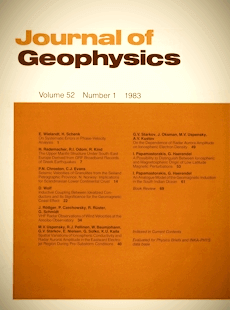The upper mantle structure under South-East Europe derived from GRF broadband records of Greek earthquakes
Article Sidebar

Vols. 1-18 (1924-1944), ISSN 0044-2801
Main Article Content
Abstract
Broadband recordings from the GRF (Grafenberg) Array of the strongest earthquakes from Greece are examined. A P-wave seismogram section of a number of events in the range between 1,300 and 2,100 km epicentral distance is constructed. The dominant feature in this section is the second arrival, which is the reflection from the 400 km discontinuity. Characteristic amplitude changes of this phase across the array are observed. The apparent velocity across the array of the first arriving P phase is very slow, indicating a slower upper mantle in SE Europe than in other regions. There is also a very weak indication of a third phase. The resulting model of the upper mantle, which was derived with the aid of theoretical seismograms, shows a pronounced discontinuity at a depth of 400 km. The time difference between the observed first two phases can be used for a fast estimation of the epicentral distance.
 ARK: https://n2t.net/ark:/88439/y035633
ARK: https://n2t.net/ark:/88439/y035633
Permalink: https://geophysicsjournal.com/article/19
Article Details
References
Burdick, L.J. (1981) A comparison of the upper mantle structure beneath north America and Europe. J. Geophys. Res. 86, 5926-5936
Burdick, L.J., Heimberger, D.V. (1978) The upper mantle P velocity structure of the Western United States. J. Geophys. Res. 83, 1699-1712
England, P.C., Worthington, M.H., King, D.W. (1977) Lateral variation in the structure of the upper mantle beneath Eurasia. Geophys. J. R. Astron. Soc. 48, 71 - 79
Given, J.W. and Heimberger, D.V. (1980) Upper mantle of Northwestern Eurasia. J. Geophys. Res. 85, 7183- 7194
Hales, A.L. (1972) The travel times of P waves and their relevance to the upper mantle velocity distribution. Tectonophysics 13, 447- 482
Hanka, W. (1982) Analysis of broad-band Rayleigh waves: a possibility for seismic discrimination. J. Geophys. 51, 165- 179
Harjes, H.-P., Seidl, D. (1978) Digital recording and analysis of broadband seismic data of the Graefenberg (GRF) Array. J. Geophys. 44, 511- 523
Kind, R. (1978) The reflectivity method for a buried source. J. Geophys. 44, 603- 612
Kind, R. (1979a) Extensions of the reflectivity method. J. Geophys. 45, 373- 380
Kind, R. (1979b) Observations of sPn from Swabian Alb earthquakes at the GRF Array. J. Geophys. 45, 337- 340
Kind, R., Seidl, D. (1982) Analysis of broadband seismograms from the Chile- Peru Area. Bull. Seismol. Soc. Am. 72, 2131- 2146
King, D.W., Calcagnile, G. (1976) P-wave velocities in the upper mantle beneath Fennoscnadia and Western Russia. Geophys. J. R. Astron. Soc. 46, 407-432
Mayer-Rosa, D., Mueller, St. (1973) The gross velocity-depth distribution of P- and S-waves in the upper mantle of Europe from earthquake observations. Z. Geophys. 39, 395-410
McKenzie, D. (1972) Active tectonics of the Mediterranean Region. Geophys. J. R. Astron. Soc. 30, 109- 185
Miiller, G., Bonjer, K.-P., Stock!, D. , Enescu, D. (1978) The Romanian earth-quake of March 4, 1977. I. Rupture process inferred from fault-plane solution and multiple-event analysis. J. Geophys. 44, 203- 218
Rakers, E., Miiller, G. (1982) The Romanian earthquake of March 4, 1977. Ill. Improved focal model and moment determination. J. Geophys. 50, 143- 150
Seidl D., Kind, R. (1982) Das instrumentelle und seismologische Konzept des Graefenburg-Array. Geol. Jahrb. £23, 207-220
Stoll, D. (1980) Determination of focal parameters of five 1976 Friuli earth-quakes from Rayleigh wave spectra. Boll. Geofis. Teor. Appl. 22(85), 3-12
Upadhyay, S.K., Duda, S.J. (1980) Source parameters of earthquakes from the Himalayan Region. J. Geophys. 48, 67- 79











